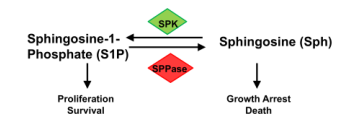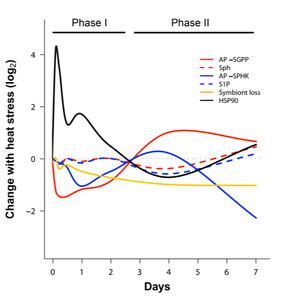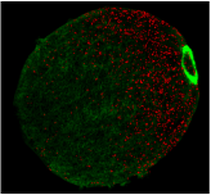Environment and Symbiosis
Sphingosine Rheostat: A Balancing Act

Lipids play a central in symbiosis, providing both cellular structure and energy storage, but little is known about how signaling lipids participate in onset and breakdown of symbiosis between cnidarians and dinoflagellates.
Signaling lipids, sphingosine (Sph) and sphingosine-1-phosphate (S1P), play a pivotal role in determining cell fate, where increased Sph drives apoptotic activity within the cell while S1P promotes cell survival. The balance of these lipids creates the ‘sphingosine rheostat’ controlled by enzymatic reactions of sphingosine kinase (SPK) and sphingosine-1-phosphatase (SPPase). A recent study demonstrated that exogenously applied sphingolipids could alter the cnidarian-dinoflagellate partnership (Detournay and Weis, 2011), however endogenous regulation of the rheostat in cnidarians has not been characterized.
Signaling lipids, sphingosine (Sph) and sphingosine-1-phosphate (S1P), play a pivotal role in determining cell fate, where increased Sph drives apoptotic activity within the cell while S1P promotes cell survival. The balance of these lipids creates the ‘sphingosine rheostat’ controlled by enzymatic reactions of sphingosine kinase (SPK) and sphingosine-1-phosphatase (SPPase). A recent study demonstrated that exogenously applied sphingolipids could alter the cnidarian-dinoflagellate partnership (Detournay and Weis, 2011), however endogenous regulation of the rheostat in cnidarians has not been characterized.

We investigated the role of rheostat in the sea anemone Exaiptasia during:
During symbiont colonization the rheostat shifted toward cell survival and under hyperthermal stress the rheostat shifted to cell death after exposure.
Collectively these data suggest that sphingolipid signaling plays a regulatory role in cnidarian-dinoflagellate symbiosis.
- symbiont re-colonization (see: Kitchen, Poole and Weis 2017, Bio. Bull.)
- thermal stress (see: Kitchen and Weis 2017, J. Exp. Bio.)
During symbiont colonization the rheostat shifted toward cell survival and under hyperthermal stress the rheostat shifted to cell death after exposure.
Collectively these data suggest that sphingolipid signaling plays a regulatory role in cnidarian-dinoflagellate symbiosis.
Manipulation of Sphingolipid Signaling in a Symbiotic Jellyfish
|
Onset of symbiosis is important to the metamorphosis of upside-down jellyfish, Cassiopea xamachana. Building on my findings with Exaiptasia, we used an inhibitor of sphingosine kinase, a key enzyme in symbiosis onset, to monitor colonization and subsequent metamorphosis of these jellyfish. This is a collaborative project with Aki Ohdera, a postdoctoral researcher at Caltech, and Angela Poole, an Assistant Professor at Berry College.
|
Cnidarian Heat-Stress Response
|
The heat-stress response (HSR) is an evolutionarily conserved defense mechanism to environmental change. Its controlled by stress sensors and signal transduction pathways to offset deleterious effects of thermal stress . These mechanisms are well-characterized in bacteria, yeast and mammals, and mediated by signaling lipids. In order to understand the breakdown of symbiosis in cnidarians, we first need to understand the series of orchestrated events involved in the HSR. My work on sea anemone Exaiptasia pallida found two phases to the cnidarian HSR:
Additional characterization is required in non-symbiotic cnidarians to refine the HSR model. See: Kitchen and Weis 2017, J. Exp Biol. |
Onset of Symbiosis in Coral Larvae under Temperature Stress
|
Very few studies have examined the combined stress of symbiosis and elevated temperature on host-symbiont associations during early developmental life stages. Understanding the mechanisms that underlie the formation of coral-algal partnership is critical to predict how coral recruitment and resilience will change in periods of warmer seas with climate change. We found that the combined stress decreased larval survival, symbiont colonization and symbiont density during two weeks of observation. Also, we identified novel transcriptional patterns in the coral molecular stress-response. Our data suggest that onset of symbiosis constrains the heat stress response of A. digitifera larvae.
Collaborators:
|


